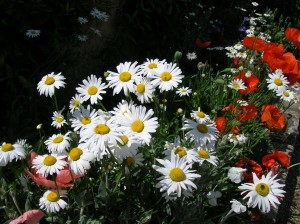Other Name Painted Shasta Daisy
Sun Requirements full sun
Bloom Period and Seasonal Color Early to late summer with white colored flowers
Mature Height x Spread 1 to 3 feet x 2 feet
Added Benefits attracts beneficials, drought tolerant, deer resistant Daisies are one of the easiest flowers to grow in the landscape. The wild or oxeye daisy is a common flower in New England wildflower mixes and is often seen in meadows and abandoned fields in our region. An improved version of the wild daisy, the Shasta daisy features larger flowers and a more stately plant. Shasta daisies have become popular perennial flower border plants because of the long bloom time of the white flowers with a yellow eye, and their tolerance to dry soils. I often have my Shasta daisies blooming twice during a growing season, especially if I deadhead regularly. Shasta daisies also make great cut flowers and bees and butterflies love to visit the flowers.
Where, When and How to Plant Most varieties of Shasta daisies are hardy to zone 5. With some protection in winter they can survive colder zones in our region. If you have problems getting your Shasta daisy plant to survive the winter, look for hardy varieties, such as “Alaska”, or consider growing the more cold tolerant, oxeye daisy. While you can sow seeds indoors under grow lights to transplant into the garden, it’s easier to plant locally purchased transplants or divide some in spring from a friend’s garden. Plant Shasta daisies in spring to early fall. Space plants 1 to 2 feet apart in a full sun location on well-drained, fertile soil.
Growing Tips Apply a layer of compost in spring around the plants for fertilizer. Keep young plants well watered. Once established, Shasta daisies are drought tolerant, so require little additional water.
Regional Advice and Care Every 3 to 4 years when the center of the clump starts to die out, divide Shasta daisy plants in spring. Dig up the whole clump and separate wedge-shaped divisions to be replanted elsewhere in the garden or given away. Most modern varieties have strong stems and don’t need staking to keep the plants from flopping over. However, if grown in part sun the stems may be weaker and will need some support. Deadhead spent flowers, cutting back the stems to the first set of leaves, once the flowers start to fade, to encourage more blooms throughout the summer.
Companion Planting and Design Shasta daisies grow well with other tall, summer blooming perennials such as coneflowers, rudbeckia, bee balm and Joe-Pye weed. Shasta daisies are a more formal addition to the wildflower meadow. Consider planting Shasta daisies in a cutting garden for use in flower arrangements.
Try These “Becky” is a widely popular, 3-foot tall Shasta daisy variety with strong, straight stems. “Alaska” also grows 3 feet tall with large, six-inch wide flowers. “Snow Lady” is a long blooming dwarf variety. “Crazy Daisy” has frilly, white flower petals. “Cobham Gold” is a double flowered, variety that grows to 2 feet tall.
Excerpted from my book, New England Getting Started Garden Guide.



